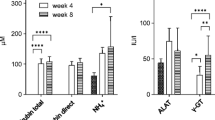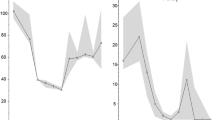Abstract
Cerebral energy metabolism, its relationship to the stage and extent of hydrocephalus, and the effect of cerebrospinal fluid (CSF) removal on it were studied in experimental canine hydrocephalus produced by intracisternal injection of kaolin by using phosphorus-31 (P-31) magnetic resonance (MR) spectroscopy and MR imaging, P-31 MR spectra were serially obtained before and after CSF removal, maximally on eight occasions over a period of nearly 5 h. There was a decrease in the ratio of creatine phosphate to inorganic phosphate, used as an indicator of the bioenergetic state, in acute and subacute stages of hydrocephalus as compared with the control. An animal in the subacute stage, when periventricular edema was most prominent, exhibited the most predominent decrease in this ratio at 14 days after hydrocephalic insult. The recovery of the ratio toward the control level was seen in the chronically hydrocephalic animal. There was no change in adenosine triphosphate (ATP) levels in any stage of hydrocephalus. Serial spectra obtained after the withdrawal of ventricular CSF showed no change in the bioenergetic state of the brain in any stage of hydrocephalus. There was no relationship between either the extent of hydrocephalus or the ventricular CSF pressure and the change in the bioenergetic state or the levels of any of the phosphorus compounds. These findings may indicate the alteration of the mitochondrial energy metabolism in hydrocephalus, which may explain the mechanism of hydrocephalic syndrome.
Similar content being viewed by others
References
Ackerman JJH, Grove TH, Wong GG, Gadian DG, Radda GK (1980) Mapping of metabolites in whole animals by P 31 NMR using surface coil. Nature 283:167–170
Bottomley PA, Hart HR, Edelstein WA (1984) Anatomy and metabolism of the normal human brain studied by magnetic resonance at 1.5 tesla. Radiology 150:441–446
Brant-Zawadzki M, Weinstein P, Bartkowski H, Moseley M (1987) MR imaging and spectroscopy in clinical and experimental cerebral ischemia. A review. AJNR 8:39–48
Brooks DJ, Beaney RP, Powell M, Leanders KL, Crockard HA, Thomas DGT, Marsball J, Jones T (1986) Studies on cerebral oxygen metabolism, blood flow, and blood volume in patients with hydrocephalus before and after surgical decompression using positron emission tomography. Brain 109:613–628
Cady EB, Del Costello AM, Dawson MJ, Delpy DT, Hope PL, Reynolds EOR, Tofts PS, Wilkia DR (1983) Non-invasive investigation of cerebral metabolism in newborn infants by phosphorus nuclear magnetic resonance spectroscopy. Lancet I:1059–1062
Campbell ID, Dobson CM, William RJP, Xavier AV (1973) Resolution enhancement of protein P MR spectra using the difference between a broadened and normal spectrum. J Magn Reson 11:172–181
Crockard HA, Godisn DG, Frachowiak RSK, Proctor E, Allen K, Williams SR, Russell RWR (1987) Acute cerebral ischemia: concurrent changes in cerebral blood flow, energy metabolites, pH, and lactate measured with hydrogen clearance and 31P and 'H nuclear magnetic resonance spectroscopy. II. Changes during ischemia. J Cereb Blood Flow Metab 7:394–402
Delpy DT, Gordon RE, Hope PL, Parker D, Reynolds EOR, Shaw D, Whitshead HD (1982) Noninvasive investigation of cerebral ischemia by phosphorus nuclear magnetic resonance. Pediatrics 70:310–313
Gardian DG, Radda GK, Ross B, Hockady J, Bore B, Taylor D, Styles P (1981) Examination of a myopathy by phosphorus nuclear magnetic resonance. Lancet II:774–775
Gardian DG, Frackowiak RSJ, Crockard HA, Proctor E, Allen K, Williams SR, Russell RWR (1987) Acute cerebral ischemia. Concurrent changes in cerebral blood flow, energy metabolites, pH, and lactate measured with hydrogen clearance and 31P and H' nuclear magnetic resonance spectroscopy. I. Methodology. J Cereb Blood Flow Metab 7:199–206
Germano IM, Pitts LH, Berry I, De Armond SJ (1988) High energy phosphate metabolism in experimental permanent focal cerebral ischemia: an in vivo 31P magnetic resonance spectroscopy. J Cereb Blood Flow Metab 8:24–31
Gonzalez-Mendez R, McNeil A, Gregory GA, Wall SD, Gooding CA, Litt L, James TL (1984) Effects of hypoxia on cerebral phosphate metabolites and pH in the anesthetized infant rabbit. J Cereb Blood Flow Metab 5:512–516
Griffiths JR, Stevens AN, Iles RA, Gordon R, Shaw D (1981) P-31 NMR investigation of solid tumors in the living rat. Biosci Rep 1:319–325
Gruff RL, Raichle ME, Jado MH, Eichling JO, Hughes CP (1977) Cerebral blood flow, oxygen utilization, and blood volume in dementia. Neurology (Minneap) 27:905–910
Gyulai L, Schnall M, McLaughlin AC, Laigh JS, Chance B (1987) Simultaneous 31P- and 'H-nuclear magnetic resonance studies of hypoxia and ischemia in the cat brain. J Cereb Blood Flow Metab 7:543–555
Hashimoto T (1987) The evaluation of brain focal ischemia using NMR techniques. Prog Comput Tomogr 9:41–46
Hayashi N, Tsubokawa T, Makiyama Y, Kumakawa I, Kawamata T (1987) Alteration of cerebral energy metabolism and cytoskeletal protein with intraparenchym routed CSF migration in the hydrocephalus. Nerv Syst Child 12:11–17
Higashi K, Asahisa G, Ueda N, Kobayashi K, Hara Y (1986) Cerebral blood flow and metabolism in experimental hydrocephalus. Neurol Res 8:169–176
Hilberman M, Subramanian DH, Haselgrove JC, Cone JB, Eban JW, Gyulai L, Chance B (1984) In vivo time-resolved brain phosphorus nuclear magnetic resonance. J Cereb Blood Flow Metab 4:334–342
Hope PL, Cady EB, Tofts PS, Hamilton PA, Costello AM, Delpy DT, Chu A, Reynolds EOR (1984) Cerebral energy metabolism studied with phosphorus NMR spectroscopy in normal and birth-asphyxiated infants. Lancet II:366–370
Horikawa Y, Naruse S, Hirakawa K, Tanaka C, Nishikawa H, Watari H (1985) In vivo studies of energy metabolism in experimental cerebral ischemia using topical magnetic resonance. Changes of P-31 nuclear magnetic resonance spectra compared with electroencephalograms and regional cerebral blood flow. J Cereb Blood Flow Metab 5:235–240
Komatsumoto S, Nioka S, Greenberg JH, Yoshizaki K, Subramanism VH, Chance B, Reivich M (1987) Cerebral energy metabolism measured in vivo by 31P NMR in middle cerebral artery occlusion in the cat — relation to severity of stroke. J Cereb Blood Flow Metab 7:557–562
Kushner M, Younkin D, Weinberger J, Hurtig H, Goidberg H, Reivich M (1984) Cerebral hemodynamics and the diagnosis of normal pressure hydrocephalus. Neurology (Cleveland) 34:96–99
Lance B, Elaff S, Leigh JS (1980) Noninvasive, nondestructive approaches to cell bioenergetics. Proc Natl Acad Sci USA 77:7430–7434
Litt L, Gonzalez-Mendez R, Severinghaus JW, Hamilton WK, Shuleshko J, Murohy-Boesch J, James TL (1985) Cerebral intracellular changes during supercarbia: an in vivo 31P nuclear magnetic resonance study in rat. J Cereb Blood Flow Metab 5:537–544
Mamo HL, Meric PC, Ponsin JC, Rey AC, Luft AG, Seylag JA (1987) Cerebral blood flow in normal pressure hydrocephalus. Stroke 18:1074–1980
Mathew NT, Meyer JS, Hartmann A, Ott EO (1975) Abnormal cerebrospinal fluid-blood flow dynamics. Implication in diagnosis, treatment, and prognosis in normal pressure hydrocephalus. Arch Neurol 32:657–664
Naritomi H, Sasaki M, Kanashiro M, Kitani M, Sawada T (1988) Flow thresholds for cerebral energy disturbance and Na pump failure as studied by in vivo 31P and 23Na nuclear magnetic resonance spectroscopy. J Cereb Blood Flow Metab 8:16–23
Naruse S, Horikawa Y, Tanaka C, Hirakawa K, Nishikawa H, Watari H (1984) In vivo measurement of energy metabolism and the concomitant monitoring of electroencephalogram in experimental cerebral ischemia. Brain Res 296:370–372
Naruse S, Horikawa Y, Tanaka C, Hirakawa K, Nishikawa H, Watari H (1984) Measurements of in vivo energy metabolism in experimental cerebral ischemia using 31P-NMR for the evaluation of protective effects of perfluorochemicals and glycerol. Neurol Res 6:169–175
Naruse S, Higuchi T, Horikawa Y, Tanaka C, Hirakawa K (1987) Pathophysiological studies of experimental brain edema and cerebral ischemia using MR I/S. Comput Tomogr Res 9:27–33
Petroff OAC, Prichard JW, Bekar KL, Alger JR, Shulman RG (1984) In vivo phosphorus nuclear magnetic resonance spectroscopy in status epilepticus. Ann Neurol 16:169–177
Radda GK, Bore PJ, Rajagopalan B (1983) Clinical aspects of P-31 NMR spectroscopy. Br Med Bull 40:155–159
Shoubridge EA, Briggs RW, Rodde GK (1982) 31P-NMR saturation transfer measurements of the steady-state of creatine kinase and ATP synthetase in the rat brain. FEBS Lett 140:288–292
Tamaki N, Kusunoki T, Wakabayashi T (1984) Cerebral hemodynamics in normal-pressure hydrocephalus. Evaluation by X-133 inhalation method and dynamic computed tomography study. J Neurosurg 61:510–514
Thulborn KR, Boulloy GH de, Duche LW (1982) A 31P nuclear magnetic resonance in vivo study of cerebral ischemia in the gerbil. J Cereb Blood Flow Metab 2:299–306
Unterberg AW, Andersen BJ, Clarke GD, Marmarow A (1988) Cerebral energy metabolism following fluid-percussion brain injury in cats. J Neurosurg 68:594–600
Vink R, McInatosh TK, Weiner MW, Faden AI (1987) Effects of traumatic brain injury on cerebral high-energy phosphates and pH:a 31P magnetic resonance spectroscopy study. J Cereb Blood Flow Metab 7:563–571
Author information
Authors and Affiliations
Rights and permissions
About this article
Cite this article
Tamaki, N., Yasuda, M., Matsumoto, S. et al. Cerebral energy metabolism in experimental canine hydrocephalus. Child's Nerv Syst 6, 172–178 (1990). https://doi.org/10.1007/BF00308496
Received:
Issue Date:
DOI: https://doi.org/10.1007/BF00308496




